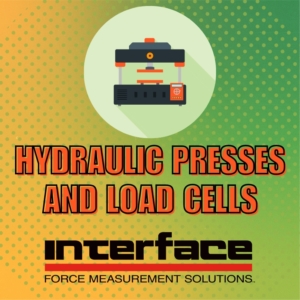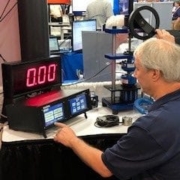Hydraulic Press Machines and Load Cells
 A hydraulic press is a machine that uses a hydraulic cylinder to generate a compressive force by applying a fluid, typically oil, to a piston. The hydraulic press works on the principle of Pascal’s Law, which states that when a fluid is subjected to pressure, it transmits that pressure equally in all directions.
A hydraulic press is a machine that uses a hydraulic cylinder to generate a compressive force by applying a fluid, typically oil, to a piston. The hydraulic press works on the principle of Pascal’s Law, which states that when a fluid is subjected to pressure, it transmits that pressure equally in all directions.
Load cells are commonly used in hydraulic presses to measure the force or weight of the load that is being applied to the press. Load cells are essentially transducers that convert a mechanical force into an electrical signal. Load cells play a critical role in ensuring the safety, quality, and efficiency of hydraulic press operations, as they allow operators to monitor and control the force being applied to the workpiece with a high degree of accuracy and precision.
In a hydraulic press, the load cell is typically placed between the ram of the press and the die, where it can measure the force that is being applied to the workpiece as defined in our Press Forming and Load Monitoring use case. The load cell is usually connected to a readout or display that shows the operator the amount of force being applied to the workpiece. This readout may be a simple analog or digital display, depending on the specific hydraulic press and load cell being used in the machine.
Hydraulic presses are widely used in manufacturing industries such as automotive, aerospace, construction, and consumer goods. They are used for applications such as metal forming, punching, stamping, bending, and assembly. The presses are used to produce consistent and high-quality parts in a cost-effective manner.
Popular load cells for hydraulic presses are Interface’s Rod End Load Cells. In a hydraulic press, a load is applied to a piston or ram using hydraulic pressure, and the force generated by the press is used for various forming, shaping, or compression processes. A rod end load cell is typically installed at the end of the piston or ram, where it can measure the tension or compression force being applied during the pressing operation. The data acquired from the rod end load cell can be used for a variety of purposes, such as monitoring the force applied to the press to ensure that it is within the desired range, controlling the press operation, or capturing data for quality control or process optimization purposes. Rod end load cells provide accurate and reliable force measurement in hydraulic presses.
Interface Rod End Load Cell Models:
- WMC Rod End Load Cell
- REC Rod End Load Cell
- WMC Sealed Stainless Steel Miniature Load Cell
- WMCP Overload Protected Stainless Steel Miniature Load Cell With Male Threads
- WMCF Miniature Sealed Stainless Steel Load Cell
- WMCFP Overload Protected Sealed Stainless Steel Miniature Load Cell With Female Threads
- WMC Sealed High Capacity Stainless Steel Miniature Load Cell
- MTFS Miniature Tension Force Load Cell
- ITCA Tension And Compression Load Cell
Load cells used for hydraulic presses typically have a high accuracy and sensitivity, as even small variations in the applied force can have a significant impact on the quality and consistency of the resulting workpiece. They are also designed to withstand the high forces and pressures that are typically involved in hydraulic press operations. There are numerous applications and use cases for hydraulic press testing, including:
Automotive and Aerospace Manufacturing: Hydraulic presses are used extensively in the manufacturing of automotive and aerospace components, where they are used to form and assemble various parts. Testing the press is important to ensure that it can handle the high forces and pressures involved in these applications.
Material Testing: Hydraulic presses are commonly used in material testing applications to test the strength and durability of various materials such as metals, plastics, and composites. The press can apply a controlled and measured amount of force to the material being tested, allowing for accurate and repeatable testing results.
Metal Forming: Hydraulic presses are often used in metal forming applications such as stamping, punching, and bending. It is important to test the press to ensure that it can apply the required force and that the resulting parts meet the necessary specifications. Read more in our Metal Press Cutting Machine application note.
Construction: Hydraulic presses are used in the construction industry for applications such as concrete forming and brick laying. The presses are used to apply a controlled amount of force to the concrete or bricks, ensuring that they are formed to the correct shape and size.
Recycling: Hydraulic presses are used in the recycling industry to compact waste materials such as cardboard, plastic, and metal. The presses are used to create dense bales of these materials that can be more easily transported and recycled.
Rubber and Plastic Molding: Hydraulic presses are also used in rubber and plastic molding applications, where they are used to form complex shapes and designs. Testing the press is necessary to ensure that it can apply the required force and that the resulting parts meet the necessary specifications.
Hydraulic presses are used in a wide range of industries and applications where a controlled and precise amount of force is required. They are used to produce high-quality parts and products in a cost-effective manner, while also ensuring safety and efficiency in the production process.
ADDITIONAL RESOURCES
Press Forming and Load Monitoring
Interface Solutions for Material Testing Engineers
Tensile Testing for 3D Materials








